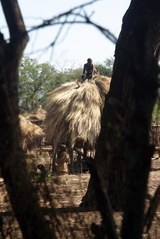Making a living

Thatching the roof of a grain store. (Ben Dome, 2004)
The Mursi practice hoe-cultivation and cattle herding. Cultivation accounts for well over half their diet while cattle, apart from being an important source of milk (especially for children) and meat, are a vital standby at times of crop failure, when they can be exchanged for grain in the highlands. The main crop is sorghum, of which they possess many drought-resistant varieties, but they also grow maize, beans and chick-peas. Because of their relatively low cattle numbers, the low and unpredictable local rainfall and the wide annual fluctuation in the level of the Omo and Mago floods, they must integrate all three of these activities by means of a complex cycle of seasonal movements.
There are two harvests each year, one along the banks of the two permanent rivers, Omo and Mago, where fertile silt is deposited by the annual flood, and one in forested areas further back from the rivers which are cleared for rain-fed, shifting cultivation. Planting takes place at the Omo and Mago in October and November, after the flood has receded and the banks have been cleared of vegetation that had grown up since the previous season. The harvest comes in January and February. River-bank land is the most valuable agricultural resource the Mursi possess. Areas liable to flood lie on both banks of the rivers, depending on the curvature of the meanders. Between October and February, when the bulk of the population is at the Omo, the cattle are kept in the wooded grasslands which rise towards the Omo-Mago watershed. The Elma valley is particularly important at this time, because it is relatively free from tsetse flies and water can usually be found at various points, even at the height of the dry season. The rain-fed crop is planted as soon as the main rains have begun, during March and April, and harvested in June or July. The onset, duration and geographical distribution of the rains varies greatly from one year to the next. It is this unpredictability, coupled with the limited area available for flood retreat cultivation, that makes cattle a vital resource for the Mursi. Apart from providing an important source of protein, in the form of milk, blood and meat, cattle and small stock can also be exchanged for grain in the nearby highlands during times of local crop failure and may thus provide a last defence against starvation for many families.
Mursi attribute overwhelming cultural importance to cattle. Virtually every significant social relationship – most notably marriage - is marked and validated by the exchange of cattle. Bridewealth (ideally consisting of 38 head of cattle) is handed over by the groom’s family to the bride’s father, who has to meet the demands of a wide range of relatives, from different clans. This ensures that cattle are continually redistributed around the community, thus helping to provide for the long term economic security of individuals and families.
More information
David Turton, ‘Mursi Response to Drought: Some Lessons for Relief and Rehabilitation’. African Affairs 84,1985, pp. 331-46
David Turton, 'Pastoral Livelihoods in Danger: Cattle Disease, Drought and Wildlife Conservation in Mursiland, Southwestern Ethiopia'. Oxfam Research Papers No. 12, Oxfam (UK and Ireland), 1995.

